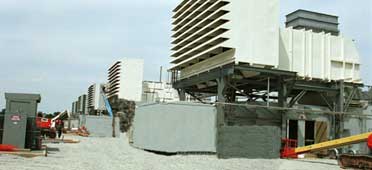Lagoon Creek Combustion Turbines and Combined Cycle Sites

Lagoon Creek Combustion Turbine Plant is located in Haywood County in west Tennessee. It is one of 12 combustion-turbine facilities in the TVA power system and one of four TVA sites with combined-cycle units.The plant site was chosen because it’s close to several natural-gas pipelines and TVA transmission lines.
Efficient power production to help meet peak demand
Taken together, Lagoon Creek's co-located combustion turbine and combined cycle sites create TVA’s largest natural-gas-fueled facility. This 181-acre facility is close to several natural-gas pipelines and TVA transmission lines. Their combined generating capacity of 1,444 megawatts helps TVA meet rapidly growing summer and winter peak demands for power.
Combustion turbines can run on natural gas or low-sulfur fuel oil and are designed to start quickly to meet the demand for electricity during peak operating periods. The simple-cycle units at Lagoon Creek can reach full power in just 20 minutes.
Combustion turbines are the most popular type of new generating equipment, accounting for 95 percent of the 300,000 megawatts of new power capacity announced for completion nationwide between 2000 and 2008.
Lagoon Creek also has two combined-cycle combustion turbines, the first of which began commercial operation in September 2010 as the first new generation source built by TVA since 2002 and the first combined-cycle natural gas facility in Tennessee.
Combined-cycle units generate 50 percent more power from the same amount of fuel compared to simple-cycle turbines. They do this by capturing the exhaust gas from one turbine and using it to produce steam that can be used to generate additional electricity from a second turbine.
State-of-the-art emission controls and noise management make Lagoon Creek combustion turbines more environmentally friendly than older types. When the units run on natural gas, nitrogen-oxide emissions are 10 percent less than from combustion turbines built 30 years ago; when burning oil, emissions are 20 percent less.